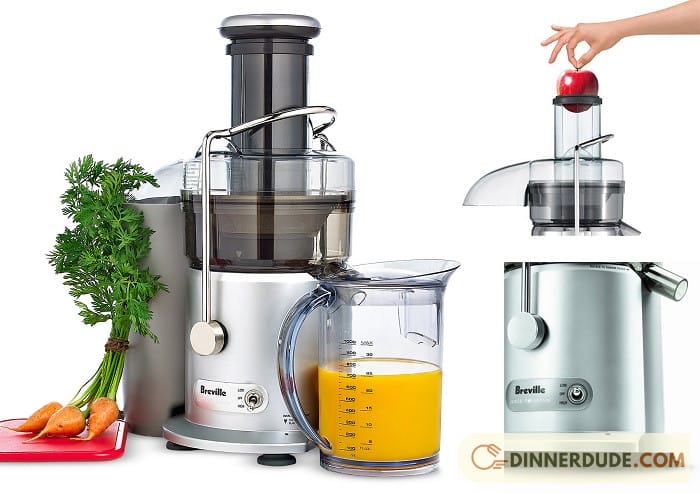Understanding the Basics of an Electric Juicer

The Main Components of an Electric Juicer
A juicer is made up of several parts that work together to extract juice from fruits and vegetables. Understanding these components will help you understand how a juicer works.
Feed Chute: The feed chute is the point at which the fruits and vegetables enter the juicer. It is usually a large opening that can hold larger pieces of produce, reducing the need for pre-cutting.
Depending on the type of juicer, it will have either an auger or a blade. Masticating juicers typically have an auger, whereas centrifugal juicers typically have a blade. Both are in charge of chopping the produce and separating the juice from the pulp.
Juice extractors include a strainer or filter that separates the pulp and fiber from the juice. This ensures a smooth and consistent texture free of unwanted solids.
Juice Container: The extracted juice is collected in the juice container. It is intended to hold a large amount of liquid, allowing you to juice multiple servings without interruption.
The pulp container, as the name implies, collects the leftover pulp and fiber from the juicing process. Some juicers have an external pulp container, while others have one built into the machine.
The motor and control panel are the driving forces behind the juicing process. It generates the force required to extract the juice from the produce. You can operate the juicer by adjusting settings such as speed and juicing time via the control panel.
These components work together to ensure efficient juice extraction, allowing you to make delicious and nutritious beverages in the comfort of your own home.
The Principle Behind Electric Juicers
The basic principle of electric juicers revolves around the extraction of juice from fruits and vegetables by using mechanical pressure provided by the motor. Depending on the type of juicer, this can be accomplished through mastication or centrifugal force. Masticating juicers crush and squeeze the produce, while centrifugal juicers shred it into pulp before spinning it rapidly to separate the liquid from the solids.
How does an electric juicer work?

Preparation and Initial Stages
Before the juice extraction process begins, fruits and vegetables need to be prepared. This usually involves washing, peeling (if necessary), and cutting them into pieces small enough to fit inside the juicer’s feed chute. Then, the produce is fed into the machine.
The Extraction and Collection Process
Once the produce has been loaded into the juicer, the motor powers on and the extraction process begins. In a masticating juicer, an auger crushes the produce against a hard surface, squeezing out the juice.
In a centrifugal juicer, sharp blades shred the produce before a high-speed spin separates the juice from the pulp.
The juice then flows through a filter and into the juice jug, while the remaining pulp is ejected into the pulp container. This process continues until all the produce has been processed, resulting in fresh, nutrient-rich juice ready for consumption.
FAQs for electric juicer work

Is it necessary to peel fruits and vegetables before juicing?
All juicers have different peeling requirements, but in general, if you would eat the skin, you don’t need to peel it.
So, for fruits like apples and pears, where you’d normally eat the skin, there’s no need to peel before juicing, but it’s worth removing the stalk and, in some juicer manuals, the core as well. Carrots do not need to be peeled, but the tops are usually removed.
If you would never eat the skin of a fruit whole, don’t juice it either. Citrus fruits, melon, and pineapple are examples of this.
Not only should you avoid juicing parts of the plant that you wouldn’t normally eat, but these tough and fibrous skins may also damage your juicer. If you have a large stone inside a fruit, such as peaches, mangoes, or cherries, you must remove the stone before putting the fruit into the juicer to avoid damaging the juicer.
Can I use a standard juicer to juice citrus?
Yes, you can usually juice all citrus fruits in both centrifugal and cold press juicers, but as previously stated, you’ll need to peel or cut off the skin first. If you plan on juicing a lot of citrus fruits, it’s worth considering whether a citrus juicer is a better option for you.
A citrus juicer will produce more juice because it is specifically designed to extract juice from citrus, and you will usually only need to cut your oranges in half instead of peeling them completely.
They come in manual or electric versions and are less expensive than many centrifugal and cold press juicers.
What is the best way to clean a juicer?
Juicers can be difficult to clean! Many juicers are difficult to assemble and disassemble, and they have several parts that make cleaning difficult.
If the fiddly cleaning bothers you, look for a juicer with dishwasher safe parts; many models now include dishwasher safe parts to make cleaning easier.

Dinnerdude hopes this provides a comprehensive overview of how an electric juicer works. Of course, different models may have specific features or use different mechanisms, but this gives a general understanding of the process.